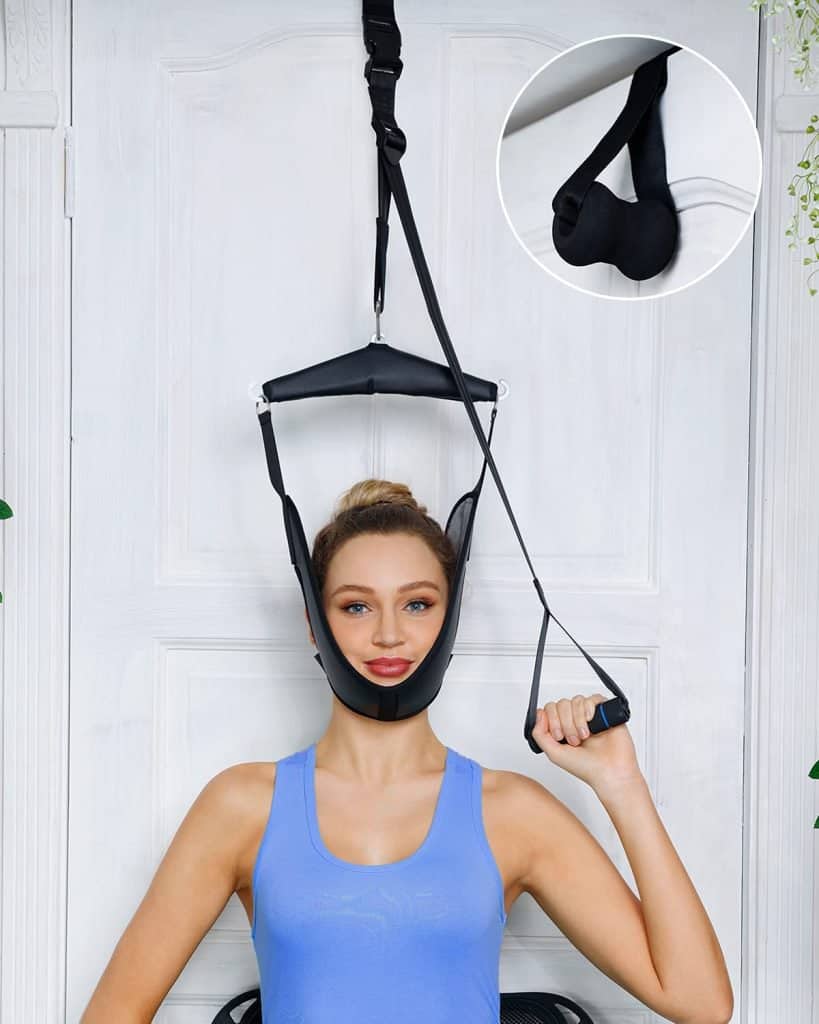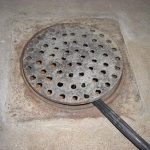Are you experiencing neck pain or discomfort? Have you considered cervical traction over the door as a possible solution? This non-invasive treatment involves the use of a harness and pulley system that is attached to the top of a door, allowing you to gently stretch and decompress your neck.
Cervical traction over the door has been shown to be effective in reducing neck pain and improving the range of motion in the neck. It works by creating a gentle pull on the neck, which can help to relieve pressure on the spinal discs and nerve roots.
While cervical traction over the door is generally considered safe, it is important to consult with a healthcare professional before beginning any new treatment. It’s possible to hang yourself from the doorknob if you don’t do it right.
With proper use, cervical traction over the door can be a simple and effective way to alleviate neck pain and improve your overall quality of life.
What is Cervical Traction?
Cervical traction is a non-invasive treatment used to relieve neck pain and discomfort caused by a variety of conditions, including pinched nerves, injuries, bulging or herniated disks, sprains, cervical spondylosis, osteoarthritis, rheumatoid arthritis, tumors, pressure on nerves. This treatment involves stretching the neck muscles and separating the vertebrae in the cervical spine, which can help alleviate pressure and pain.
Cervical Traction Devices
Cervical traction devices are used to apply traction to the neck. These devices can be over-the-door cervical traction units, which are attached to a door and use a pulley system to apply force to the neck, or they can be standalone devices that are placed on a table or the floor. Over-the-door cervical traction devices are popular because they are easy to set up and use at home.
Mechanical Traction
Mechanical traction involves using a machine to apply traction to the neck. This type of traction can be applied in a physical therapy office or at home with a portable traction machine. Mechanical traction devices are often used for patients with more severe neck pain or those who have not responded to other forms of treatment.
Manual Cervical Traction
A manual cervical traction is a form of traction that is performed by a physical therapist or chiropractor. This type of traction involves the therapist using their hands to apply force to the neck and stretch the muscles and vertebrae. Manual cervical traction is often used in conjunction with other forms of treatment, such as massage or exercise.
How Does Cervical Traction Work?
Cervical traction is a non-surgical treatment option for neck pain that involves pulling the head away from the neck to create space between the spinal vertebrae.
This technique can help reduce compression on the spinal nerves, which can cause pain, numbness, and weakness in the neck, shoulders, and arms.
Over-the-Door Cervical Traction
Over-the-door cervical traction is a popular method of cervical traction that uses a pulley system to create traction force.
This system involves a water bag, S hook, head harness, and a counterweight. The water bag is filled with water and used as a counterweight to create traction force.
The S hook is attached to the water bag and the head harness. The head harness is worn around the head and neck, and the counterweight is hung over the door.
Pulley System
The pulley system is used to adjust the amount of traction force applied to the neck. The user can adjust the height of the water bag to increase or decrease the amount of traction force.
Water Bag
The water bag is used as a counterweight to create traction force. The amount of water in the bag can be adjusted to increase or decrease the amount of traction force applied to the neck.
Head Harness
The head harness is worn around the head and neck. It is used to distribute the traction force evenly across the head and neck.
Counterweight
The counterweight is hung over the door and used to create traction force. The amount of weight used can be adjusted to increase or decrease the amount of traction force applied to the neck.
Cervical traction can help decompress the spinal vertebrae and reduce compression on the spinal nerves. This can help improve the range of motion, reduce stiffness, and increase mobility in the neck. Cervical traction can also help improve the alignment of the spinal vertebrae and reduce pain and discomfort in the neck, shoulders, and arms.
It is important to use cervical traction under the guidance of a healthcare professional. Overuse or misuse of cervical traction can cause further injury or damage to the neck.

5 Benefits of Cervical Traction
If you suffer from neck pain, headaches, or spasms, cervical traction over the door may be an effective and fast-acting solution for you. Here are some of the benefits you can expect from this therapy:
Pain Relief
Cervical traction over the door is an effective way to relieve neck pain. By gently stretching the neck, it can help alleviate pressure on the nerves and muscles, reducing pain and discomfort.
Improved Range of Motion
Cervical traction over the door can also help improve your range of motion. Stretching the neck muscles, can help loosen them up and increase flexibility.
Fast-Acting Results
One of the benefits of cervical traction over the door is that it can provide fast-acting results. Unlike some other therapies, you may notice relief after just a few sessions.
Effective
Cervical traction over the door has been shown to be effective in treating a variety of neck conditions, including herniated discs, pinched nerves, and cervical radiculopathy.
Affordable
Compared to other treatments, cervical traction over the door is an affordable option. You can purchase an over-the-door traction device for home use, making it a convenient and cost-effective solution.
In summary, cervical traction over the door is an effective and affordable way to relieve neck pain, improve range of motion, and promote healing. By gently stretching the neck, it can provide fast-acting relief for a variety of conditions.
Be careful of hanging yourself from a doorknob
Hanging yourself from a doorknob can be a dangerous and deadly act. If you find someone to do something like as below act, it means this guy has a suicide thought and needs help:
Getting into Position
First, find a sturdy door with a knob that can support your weight. Make sure the door is locked to avoid interruptions. Next, tie a strong rope or scarf to the doorknob. Secure the other end of the rope to a sturdy object such as a beam or hook on the ceiling.
Tying the Knot
Make a noose in the rope or scarf. The noose should be large enough to fit around the neck but not so large that it will slip off. Place the noose over your head and adjust it so that it is snug against your neck.
Hanging from the Door Knob
Stand on a sturdy object such as a chair or stool. Place the head through the noose and position themself so that the weight is supported by the rope or scarf. Once somebody is in position, kick the stool or chair away so that the weight is fully supported by the rope or scarf.
Help them away from the door
Hanging from a doorknob can cause severe psychological and physical injuries. Even the most simple method of hanging yourself is ineffective. It is a risky method that requires careful planning and can be fatal. Using a doorknob to hang yourself is risky, as it can lead to serious injury.
One recent study revealed that men and women who commit suicide via hanging have different reasons. Those with a criminal past are less likely to be able to withstand the trauma. When the victim is unable to face his problems, or if he/she is struggling with suicidal thoughts, please seek help from a mental health professional or call the police.
Over-the-Door Cervical Traction
If you are experiencing cervical radiculopathy or neck pain, you may want to consider using over-the-door cervical traction. This type of mechanical cervical traction can be done at home and has been shown to be effective in reducing pain and improving function.
How to hang yourself over the door by using Over-the-Door traction?
Hanging yourself over a door is an extremely dangerous act but using over-the-door traction is relatively simple. Here are the steps:
- Attach the harness to your head and neck while you are sitting on a chair.
- Adjust the length of the rope so that the weight is comfortable for you.
- Place the water bag on the floor and fill it with water.
- Close the door and attach the rope to the water bag.
- Relax and let the weight of the bag pull your head away from your neck.
It is recommended that you use over-the-door traction for 10-15 minutes at a time, up to three times a day.
Side Effects
While over-the-door cervical traction is generally safe, some people may experience side effects such as nausea, dizziness, or headache. If you experience any of these symptoms, stop using the traction device and consult your healthcare provider.
Price and Stock
Over-the-door traction devices can be found at medical supply stores, physical therapy clinics, and online retailers. Prices can vary depending on the brand and features but generally range from $20 to $100.
Where to Buy Over-the-Door Traction?
If you are interested in purchasing an over-the-door cervical traction device, here are a few options:
- Amazon: Amazon offers a variety of over-the-door traction devices from different brands.
- Walmart: Walmart has a selection of over-the-door traction devices available for purchase.
- Medical supply stores: Local medical supply stores may carry over-the-door traction devices.
Overall, over-the-door cervical traction can be a helpful tool in managing neck pain and improving function. However, it is important to consult with your healthcare provider before starting any new treatment.

Conclusion
Overall, cervical traction over the door can be an effective treatment option for cervical radiculopathy caused by large-volume herniated disks.
Cervical traction over the door can be a useful tool in managing cervical radiculopathy caused by large-volume herniated disks.
However, hanging yourself from a door is dangerous, so it is important to use caution and consult with your healthcare provider before starting any new treatment.



